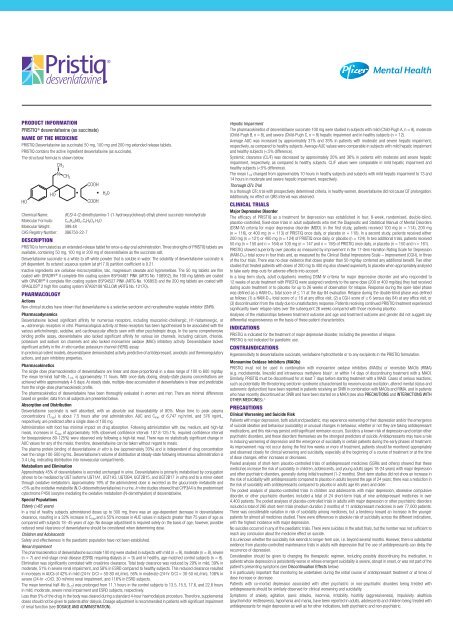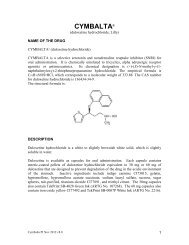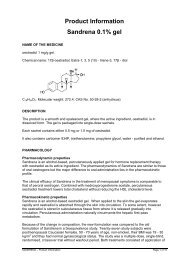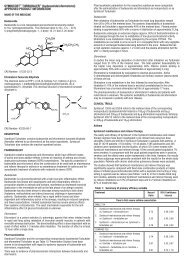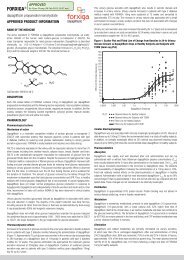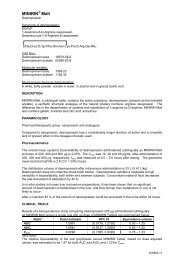PRODUCT INFORMATION PRISTIQ ... - Drivetime Radio
PRODUCT INFORMATION PRISTIQ ... - Drivetime Radio
PRODUCT INFORMATION PRISTIQ ... - Drivetime Radio
Create successful ePaper yourself
Turn your PDF publications into a flip-book with our unique Google optimized e-Paper software.
<strong>PRODUCT</strong> <strong>INFORMATION</strong><strong>PRISTIQ</strong> ® desvenlafaxine (as succinate)NAME OF THE MEDICINE<strong>PRISTIQ</strong> Desvenlafaxine (as succinate) 50 mg, 100 mg and 200 mg extended release tablets.<strong>PRISTIQ</strong> contains the active ingredient desvenlafaxine (as succinate).The structural formula is shown below:CH 3NCH 3COOHHOH 2 0HOCOOHChemical Name: (R,S)-4-(2-dimethylamino-1-(1-hydroxycyclohexyl) ethyl) phenol succinate monohydrateMolecular Formula: C 16H 25NO 2.C 4H 6O 4.H 2OMolecular Weight: 399.48CAS Registry Number: 386750-22-7DESCRIPTION<strong>PRISTIQ</strong> is formulated as an extended-release tablet for once-a-day oral administration. Three strengths of Pristiq tablets areavailable, containing 50 mg, 100 mg or 200 mg of desvenlafaxine as the succinate salt.Desvenlafaxine succinate is a white to off-white powder that is soluble in water. The solubility of desvenlafaxine succinate ispH dependent. Its octanol: aqueous system (at pH 7.0) partition coefficient is 0.21.Inactive ingredients are cellulose-microcrystalline, talc, magnesium stearate and hypromellose. The 50 mg tablets are filmcoated with OPADRY ® II complete film coating system 85F94487 PINK (ARTG No. 106952), the 100 mg tablets are coatedwith OPADRY ® II complete film coating system 85F94527 PINK (ARTG No. 106953) and the 200 mg tablets are coated withOPAGLOS ® 2 high film coating system 97A92108 YELLOW (ARTG No. 12170).PHARMACOLOGYActionsNon-clinical studies have shown that desvenlafaxine is a selective serotonin and noradrenaline reuptake inhibitor (SNRI).PharmacodynamicsDesvenlafaxine lacked significant affinity for numerous receptors, including muscarinic-cholinergic, H1-histaminergic, orα 1-adrenergic receptors in vitro. Pharmacological activity at these receptors has been hypothesised to be associated with thevarious anticholinergic, sedative, and cardiovascular effects seen with other psychotropic drugs. In the same comprehensivebinding profile assay, desvenlafaxine also lacked significant affinity for various ion channels, including calcium, chloride,potassium and sodium ion channels and also lacked monoamine oxidase (MAO) inhibitory activity. Desvenlafaxine lackedsignificant activity in the in vitro cardiac potassium channel (hERG) assay.In preclinical rodent models, desvenlafaxine demonstrated activity predictive of antidepressant, anxiolytic and thermoregulatoryactions, and pain inhibitory properties.PharmacokineticsThe single dose pharmacokinetics of desvenlafaxine are linear and dose-proportional in a dose range of 100 to 600 mg/day.The mean terminal half-life, t1/2, is approximately 11 hours. With once-daily dosing, steady-state plasma concentrations areachieved within approximately 4-5 days. At steady state, multiple-dose accumulation of desvenlafaxine is linear and predictablefrom the single-dose pharmacokinetic profile.The pharmacokinetics of desvenlafaxine have been thoroughly evaluated in women and men. There are minimal differencesbased on gender; data from all subjects are presented below.Absorption and DistributionDesvenlafaxine succinate is well absorbed, with an absolute oral bioavailability of 80%. Mean time to peak plasmaconcentrations (Tmax) is about 7.5 hours after oral administration. AUC and C max of 6,747 ng.hr/mL and 376 ng/mL,respectively, are predicted after a single dose of 100 mg.Administration with food has minimal impact on drug absorption. Following administration with low, medium, and high-fatmeals, increases in Cmax of approximately 16% (observed confidence interval: 107.8-125.1%; required confidence intervalfor bioequivalence 80-125%) were observed only following a high-fat meal. There was no statistically significant change inAUC values for any of the meals; therefore, desvenlafaxine can be taken without regard to meals.The plasma protein binding of desvenlafaxine in vitro is low (approximately 30%) and is independent of drug concentrationover the range 100-500 ng/mL. Desvenlafaxine’s volume of distribution at steady-state following intravenous administration is3.4 L/kg, indicating distribution into nonvascular compartments.Metabolism and EliminationApproximately 45% of desvenlafaxine is excreted unchanged in urine. Desvenlafaxine is primarily metabolised by conjugation(shown to be mediated by UGT isoforms UGT1A1, UGT1A3, UGT2B4, UGT2B15, and UGT2B17 in vitro) and to a minor extentthrough oxidative metabolism. Approximately 19% of the administered dose is excreted as the glucuronide metabolite and65 years)In a trial of healthy subjects administered doses up to 300 mg, there was an age-dependent decrease in desvenlafaxineclearance, resulting in a 32% increase in Cmax and a 55% increase in AUC values in subjects greater than 75 years of age ascompared with subjects 18-45 years of age. No dosage adjustment is required solely on the basis of age; however, possiblereduced renal clearance of desvenlafaxine should be considered when determining dose.Children and AdolescentsSafety and effectiveness in the paediatric population have not been established.Renal ImpairmentThe pharmacokinetics of desvenlafaxine succinate 100 mg were studied in subjects with mild (n = 9), moderate (n = 8), severe(n = 7) and end-stage renal disease (ESRD) requiring dialysis (n = 9) and in healthy, age-matched control subjects (n = 8).Elimination was significantly correlated with creatinine clearance. Total body clearance was reduced by 29% in mild, 39% inmoderate, 51% in severe renal impairment, and 58% in ESRD compared to healthy subjects. This reduced clearance resultedin increases in AUCs of 42% in mild (24-hr CrCl = 50-80 mL/min), 56% in moderate (24-hr CrCl = 30-50 mL/min), 108% insevere (24-hr
Drugs Metabolised by CYP1A2, 2A6, 2C8, 2C9 and 2C19In vitro, desvenlafaxine does not inhibit CYP1A2, 2A6, 2C8, 2C9, and 2C19 isozymes and would not be expected to affect thepharmacokinetics of drugs that are metabolised by these CYP isozymes.P-glycoprotein TransporterIn vitro, desvenlafaxine is not a substrate or an inhibitor for the P-glycoprotein transporter.ADVERSE EFFECTSClinical Trials ExperienceThe safety of desvenlafaxine was established in a total of 4,724 patients, who were exposed to at least one dose ofdesvenlafaxine ranging from 50 to 400 mg/day in clinical trials. Long-term safety was evaluated in 1,576 patients, who wereexposed to desvenlafaxine for at least 6 months and with 575 patients exposed for 1 year.The following list of adverse reactions was reported by patients treated with desvenlafaxine throughout the dose range studied(50 to 400 mg) during both short- and long-term trials. In general, the adverse reactions were most frequent in the first weekof treatment.Adverse reactions are listed below in CIOMS frequency categories:Very Common ≥ 10%Common: ≥ 1% and < 10%;Uncommon: ≥ 0.1% and < 1%;Rare: ≥ 0.01% and < 0.1%;Very Rare: < 0.01%.Not Known:Cannot be estimated from the data available.System Organ ClassCardiac DisordersCommon:Adverse ReactionPalpitations, tachycardiaEar and Labyrinth DisordersCommon:Tinnitus, vertigo**Eye DisordersCommon:Vision blurred, mydriasisGastrointestinal DisordersVery CommonNausea, dry mouth, constipationCommon:Diarrhoea, vomitingGeneral Disorders and Administration Site ConditionsVery CommonFatigueCommon:Chills, asthenia, feeling jittery, irritabilityImmune System DisordersUncommon:HypersensitivityInvestigationsCommon:Uncommon:Metabolism and Nutritional DisordersCommon:Decreased appetiteRare: Hyponatraemia ±Weight increased, blood pressure increased, weight decreased, blood cholesterol increasedBlood triglycerides increased, liver function test abnormal, blood prolactin increasedMusculoskeletal, Connective Tissue and Bone DisordersCommon:Musculoskeletal stiffnessNervous System DisordersVery Common:Dizziness, headacheCommon:Somnolence, tremor, paraethesia, dysgeusia, disturbance in attentionUncommon:SyncopeRare:Convulsion, extrapyramidal disorderPsychiatric DisorderVery Common:InsomniaCommon:Anxiety, abnormal dreams, nervousness, libido decreased, anorgasmia, orgasm abnormalUncommon: Depersonalisation, hypomania, withdrawal syndrome ±Rare: Hallucinations ±Renal and Urinary DisordersCommon:Urinary hesitationRare: Proteinuria, urinary retention** ±Reproductive System and Breast DisordersCommon:Erectile dysfunction*, ejaculation delayed*, ejaculation disorder*, ejaculation failure*Uncommon:Sexual dysfunctionRespiratory, Thoracic and Mediastinal DisordersCommon:YawningUncommon:EpistaxisSkin and Subcutaneous Tissue DisordersVery Common:HyperhidrosisCommon:RashUncommon: Alopecia** ±Rare: Angioedema**, photosensitivity reaction ±Not Known: Stevens-Johnson syndrome** ±Vascular DisordersCommon:Hot flushUncommon: Orthostatic hypotension, peripheral coldness ±* Frequency is calculated based on men only.** Adverse reaction identified during post-approval use.Adverse Reactions Reported with Other SNRIsAlthough the following are not considered adverse reactions for desvenlafaxine succinate, they are adverse reactions for otherSNRIs and may also occur with desvenlafaxine succinate: gastrointestinal bleeding and severe cutaneous reactions (such asStevens - Johnson syndrome, toxic epidermal necrolysis and/or erythema multiforme).Ischaemic Cardiac Adverse EventsIn clinical trials, there were uncommon reports of ischaemic cardiac adverse events including myocardial ischaemia,myocardial infarction, and coronary occlusion requiring revascularisation; these patients had multiple underlying cardiac riskfactors. More patients experienced these events during Pristiq treatment as compared to placebo (see PRECAUTIONS –Cardiovascular/Cerebrovascular Disease).Discontinuation SymptomsAdverse drug reactions reported in association with abrupt discontinuation, dose reduction or tapering of treatment in MDDclinical trials at a rate of ≥ 5% include: dizziness, withdrawal syndrome ± , nausea, headache, irritability, diarrhoea, anxiety,abnormal dreams, fatigue, and hyperhidrosis. In general, discontinuation symptoms occurred more frequently with longerduration of therapy (see DOSAGE AND ADMINISTRATION and PRECAUTIONS – Discontinuation Effects).Orthostatic HypotensionOf the 3,292 patients in clinical trials with Prisitq, 5% of patients were 65 years of age or older. No overall differences insafety or efficacy were observed between these patients and younger patients; however, in the short-term placebo-controlledtrials, there was a higher incidence of systolic orthostatic hypotension in patients ≥ 65 years of age compared to patients< 65 years of age treated with Pristiq.Adverse Reactions Leading to Discontinuation of TherapyThe most common adverse reactions leading to discontinuation in at least 2% of the desvenlafaxine-treated patients in theshort-term trials, up to 8 weeks, were: nausea (4%); dizziness and vomiting (2% each); in the long-term trial, up to 9 months,the most common was vomiting (2%).DOSAGE AND ADMINISTRATIONPristiq should be taken at approximately the same time each day. Tablets must be swallowed whole with fluid and not divided,crushed, chewed, or dissolved.Initial TreatmentThe recommended dose for Pristiq is 50 mg once daily, with or without food. In clinical trials, doses of 50-400 mg/day wereshown to be effective, although no additional benefit was demonstrated at doses greater than 50 mg/day. Based on clinicaljudgment, if dose increases are indicated for individual patients, they should occur gradually and at intervals of not less than7 days. The maximum dose should not exceed 200 mg/day.When discontinuing therapy, gradual dose reduction is recommended whenever possible to minimise discontinuationsymptoms (see PRECAUTIONS and ADVERSE EFFECTS).Maintenance/Continuation/Extended TreatmentIt is generally agreed that acute episodes of major depressive disorder require several months or longer of sustainedpharmacological therapy. The efficacy of Pristiq (200-400 mg) in major depressive disorder was demonstrated in the24-week double-blind phase of a relapse prevention trial in patients who had responded during an initial, 12-week open-labelphase (see CLINICAL TRIALS). Patients should continue on the same dose at which they were stabilised. They should beperiodically reassessed to determine the need for continued treatment.Children and AdolescentsSafety and efficacy in patients less than 18 years of age have not been established.Dosage Adjustment in Renal ImpairmentThe recommended starting dose in patients with severe renal impairment (24-hr CrCl < 30 mL/min) or end-stage renal disease(ESRD) is 50 mg every other day. Because of individual variability in clearance in these patients, individualisation of dosage maybe desirable. Supplemental doses should not be given to patients after dialysis (see PHARMACOLOGY).Dosage Adjustment in Hepatic ImpairmentNo adjustment of dose is necessary in patients with mild, moderate, and severe hepatic impairment (see PHARMACOLOGY).Dosage Adjustment in the ElderlyNo dosage adjustment is required solely on the basis of age; however, possible reduced renal clearance of Pristiq should beconsidered when determining dose (see PHARMACOLOGY).Discontinuing PristiqWhen discontinuing therapy gradual dose reduction should be considered to minimise discontinuation symptoms(see PRECAUTIONS and ADVERSE EFFECTS).Symptoms associated with discontinuation of Pristiq, as well as other SNRIs and SSRIs have been reported(see PRECAUTIONS). Patients should be monitored for these symptoms when discontinuing treatment. A gradual reductionin the dose rather than abrupt cessation is recommended whenever possible. If intolerable symptoms occur following adecrease in the dose or upon discontinuation of treatment, then resuming the previously prescribed dose may be considered.Subsequently, the physician may continue decreasing the dose, but at a more gradual rate (see PRECAUTIONS and ADVERSEEFFECTS).Switching Patients from Other Antidepressants to PristiqDiscontinuation symptoms have been reported when switching patients from other antidepressants, including venlafaxineto desvenlafaxine. Tapering of the initial antidepressant followed by a washout period may be necessary to minimisediscontinuation symptoms and the possibility of drug-drug interactions from a pharmacokinetic or pharmacodynamicperspective.Residual Inert Tablet MatrixPatients receiving Pristiq may notice an inert matrix tablet passing in the stool or via colostomy.Patients should be informed that the active medication has already been absorbed by the time the patient sees the inertmatrix tablet.OVERDOSAGEThere is limited clinical experience with desvenlafaxine overdosage in humans. In clinical trials, no cases of fatal acuteoverdose of desvenlafaxine succinate were reported.Among the patients included in the major depressive disorder trials of Pristiq, there were four adults who ingested dosesgreater than 800 mg of desvenlafaxine (4000 mg [desvenlafaxine alone], 900, 1800 mg and 5200 mg [in combinationwith other drugs]); all patients recovered. In addition, a patient’s 11-month-old child accidentally ingested 600 mg ofdesvenlafaxine, was treated, and recovered.Management of OverdoseIn managing an overdose, consider the possibility of multiple drug involvement. The physician should consider contactinga poison control centre for additional information on the treatment of any overdose. For information on the management ofoverdose, contact the Poison Information Centre on 131126.Treatment should consist of those general measures employed in the management of overdosage with any SSRI/SNRI.General supportive and symptomatic measures are recommended. Ensure an adequate airway, oxygenation and ventilation.Cardiac rhythm and vital signs must be monitored. Administration of activated charcoal may also limit drug absorption. Wherethere is a risk of aspiration, induction of emesis is not recommended. No specific antidotes for desvenlafaxine are known.Forced diuresis, dialysis, haemoperfusion and exchange transfusion are unlikely to be of benefit.PRESENTATION AND STORAGE CONDITIONS<strong>PRISTIQ</strong> ® (desvenlafaxine) extended-release tablets are available as follows:50 mg light pink, square pyramid tablet debossed with “W” (over) “50” on the flat side. Cartons containing 7 or 28 tablets.100 mg reddish-orange, square pyramid tablet debossed with “W” (over) “100” on the flat side. Cartons containing 7 # or 28 tablets.200 mg yellow, square pyramid tablet debossed with “W” (over) “200” on the flat side. Cartons containing 28 tablets. ##Not marketed.StorageStore below 25°C.NAME AND ADDRESS OF THE SPONSORPfizer Australia Pty LtdABN 50 008 422 34838-42 Wharf RoadWest Ryde NSW 2114.POISON SCHEDULE OF THE MEDICINESchedule 4 – Prescription Only Medicine.DATE OF FIRST INCLUSION IN THE AUSTRALIAN REGISTER OF THERAPEUTIC GOODS18 August 2008.DATE OF MOST RECENT AMENDMENT10 December 2012.±Please note change to Product Information.®Registered trademark.BLUE1172 PXXXX FEB 2013


